Class A+
Class A
 |
Continuum Audio Labs Caliburn: $149,995 with tonearm and stand ✩ "Part New Jersey diner, part Wurlitzer jukebox," the 160 lb Caliburn is the brainchild of Mark Doehmann, whose clever, purposeful design is based on rigorous scientific methodology using finite-element analysis computer programs. While the only serious competition for the Caliburn is the Rockport System III Sirius, MF decided, "The Caliburn beat the Rockport's overall performance by a considerable margin," adding an "emotional majesty" that made the Rockport seem analytical. "Better than sex!" cried Mikey's wife, though compared to the Onedof turntable, while the Caliburn offered greater dynamics, transparency, and impact, it sounded slightly ragged and less stable, said MF. The ultrarigid Castellon stand, made of chromed, aircraft-grade aluminum, costs $25k on its own (pheww). Stereophile’s 2006 "Analog Source Component" and "Overall Product of the Year." (Vol.29 No.1, Vol.31 No.3, Vol.35 No.7 Read Review Online) |
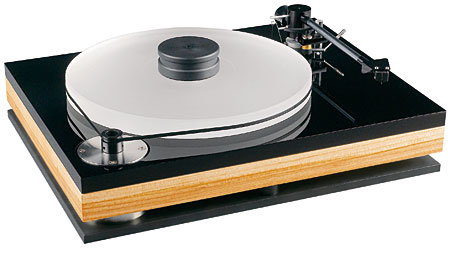 |
Ayre/dps: $9250 without tonearm In Willi Bauer's handsome dps, an aluminum plinth houses three shallow PVC cups, filled with elastomer buttons, that act as supporting springs for the rest of the turntable. The body is a laminate of six separate sheets: two layers of lossy damping material sandwiched by three sheets of Baltic birch plywood and topped with a layer of cork; the platter is acrylic. Bauer prevents energy storage by combining a resistive bearing with a high-torque AC synchronous motor, this powered by a three-phase power supply custom-made by Ayre Acoustics. Though it lacked the bottom-end heft of AD's Thorens TD-124, the dps showed unsurpassed pitch stability and revelatory soundstaging abilities. "A striking, innovative success," Art enthused. dps tonearm adds $3500. (Vol.33 No.4 Read Review Online) |
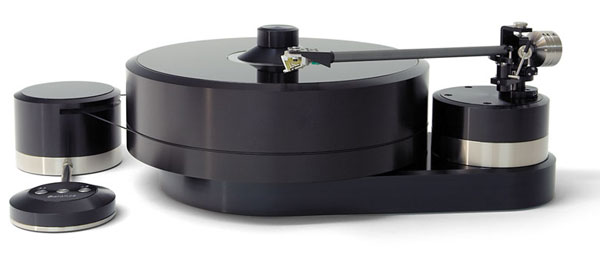 |
Brinkmann Balance: $24,700 ✩ The ready-to-play Brinkmann Balance is a plinthless "table with an attractive, low-profile base available in a variety of sizes and configured for specified tonearm masses. Its high-tech feet are designed to effectively isolate the supporting base from horizontally and vertically induced vibrations, and its platter's speed can run at precisely 33.3 and 45rpm. Combined "deep, tight, articulate" bass performance with "the lightest, airiest, purest" soundstages to breathe new life into MF's favorite LPs, adding "greater holography of imaging but without etch." Recent upgrades include a new motor and new power-supply electronics. Adding Brinkmann's optional RöNt tubed power supply ($4300) produced cleaner, better-articulated mid- and high-frequency transients, said MF. "The Brinkmann Balance remains one of a handful of the finest turntables being made today." Brinkmann 12.1 tonearm adds $7500, Brinkmann EMT-ti cartridge adds $4300. (Vol.28 No.5; Vol.35 No.4 Read Review Online) |
 |
Brinkmann Bardo: $7990 without tonearm The Bardo is a direct-drive, suspensionless turntable with an eight-pole, speed-controlled motor. It has a vinyl platter mat, a polished granite base, and the superbly designed and machined spindle and bearing used in Brinkmann's more expensive Oasis, La Grange, and Balance models. Fit’n’finish were outstanding, and setup was quick and simple. Though it lacked the rich, deep bass of Brinkmann's more expensive "tables, the Bardo "produced superbly well-organized sound with clean, sharp attacks, reasonably strong sustain, and pronounced decay, all against a jet-black backdrop," said Mikey. Optional precision-ground crystal platter mat and screw-down record clamp add $1500; optional Balance power supply adds $1490. (Vol.34 No.5 Read Review Online) |
 |
Dr. Feickert Blackbird: $7995 without tonearm Easy to set up and use, the Blackbird is a mass-loaded design that can simultaneously accommodate two tonearms, each mounted on a precision-machined armboard of polyoxymethalene copolymer (POM-C). A thick slab of thermally treated MDF is sandwiched between two aluminum plates to form the Blackbird's attractive plinth, which in turn supports the 9-lb POM-C platter and houses the proprietary motor controller. The Blackbird traded bottom-end extension for rhythmic clarity, producing an overall sound that was open, uncolored, and slightly lean, said MF. Though "a likable product," the Blackbird "would be far more attractive and easier to recommend if it sold for $1000 less," he decided. (Vol.34 No.9) |
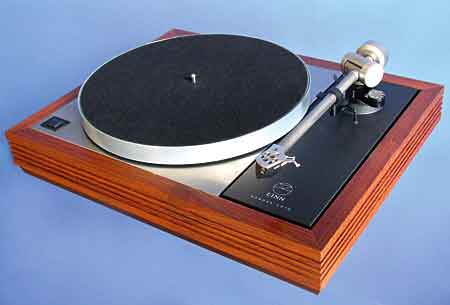 |
Linn Sondek LP12, with Lingo power supply: $5010+, depending on finish and options ✩ Compared with Linn's original Valhalla, the Lingo-equipped Sondek minimizes the LP12's propensity toward a slightly fat midbass, subjectively extending the low frequencies by another octave. The Lingo upgrade alone costs $1810. The Trampolin suspension reduces the effect of the support. Cirkus bearing/subchassis, fitted as standard, costs $750 including labor as an upgrade kit, and further extends and tightens the "table's bass, leading to a borderline Class A rating, according to MC, JA, AD, and LG (as long as a good support is used, adds MC). "A deeper, more profound silence," enthuses WP over the Cirkus mod, adding that what stunned him was "the extent to which surface noise receded into insignificance." MF agreed: "Everything its fans say about it is true: It can carry a tune, it's well-paced, and it has impressive bass extension and supple, believable bass transients." Superbly low measured rumble and excellent speed stability reinforce the feeling of maximum musical involvement offered by this classic belt-drive turntable. Good isolation from shock and vibration. While the felt mat doesn't offer the greatest degree of vibration suppression within the vinyl disc, what absorption it does offer is uniform with frequency. The Lingo"d Linn was "a big-sounding, wildly dynamic, faultlessly tuneful player that held me utterly rapt," said AD. In direct comparison, the Lingo-Ekos combination sounded more dynamic than the Naim Armageddon-Aro combo, AD added. "The Naim Armageddon was easy to listen to. The Linn Lingo was hard to ignore." The Keel one-piece subchassis, tonearm board, and Linn-specific tonearm mounting collar ($3250) maintained the sonic character of AD's LP12 while adding size, richness, and detail. "To the person who understands what the player is all about, this very expensive upgrade could border on being essential," said Art, who feels that high Class B is the appropriate rating. Effects of the Trampolin base ($250) were not as pronounced. Despite flirtations with other decks, JA remains true to the basic design he has used now for more than a quarter century. The Radikal, Linn's 2010-vintage upgrade for the LP12 ($4250), combines a DC motor with an outboard switch-mode power supply and control unit. Housed in a shell of machined acetal and aluminum, the motor includes neodymium magnets, precious-metal brushes, and a rotor design said to virtually eliminate electromagnetic interference and magnetic cogging. While it maintained the LP12's natural warmth and superb musical flow, the Radikal presented music with greater force, momentum, and clarity, for a more satisfying and altogether easier listening experience, said AD, leading to a revised Class A rating. (Vol.7 No.2, Vol.13 No.3, Valhalla; Vol.14 No.1, Vol.16 No.12, Vol.17 No.5, Vol.19 No.2, Vol.26 No.11, Vol.28 No.2 Read Review Online; Vol.30 No.10 Read Review Online; Vol.34 No.6 Read Review Online) |
 |
Onedof turntable: $150,000 when reviewed The audacious Onedof (One Degree of Freedom) turntable comprises three towers, one each for the motor, the tonearm, and the massive platter bearing, the last also serving as the platter's pedestal. The self-centering bearing system has no points of solid contact and generates virtually no heat. To ensure that an LP rests flatly against the platter, the Onedof employs a massive central weight and a gold-plated platter ring. Compared to Mikey's Continuum Caliburn, the Onedof sounded smoother, silkier, and less mechanical, but lacked dynamic expression, transparency, and impact, which keeps it from Class A+. "I'd take a new Rega RP6 for roughly 1/100th the price," snorts ST. Sold factory direct to order only. (Vol.35 No.7) |
 |
Oracle Delphi Mk.VI: $15,650, as reviewed Among the best-looking turntables ever made," the latest incarnation of the Oracle Delphi exhibits flawless fit and finish, and includes Oracle's Turbo power supply and a dedicated power cord. The Delphi's aluminum subchassis has been made thicker and heavier for improved resonance control, and its spindle-bearing screws have been improved for greater accuracy and tighter tolerances. In addition, the Delphi now employs a Micro Vibration spring-suspended subchassis said to offset any lateral and/or vertical microdisplacements while isolating the turntable from footfalls. Matched with the Lyra Helikon SL phono cartridge, the Delphi produced fast transients, a supple midrange, and deep, focused bass. "A formidable contender in and well beyond its price class," said MF. (Vol.33 No.3 Read Review Online) |
 |
SME 20/12: $22,500, with 312S tonearm Among the best-built turntables in the world," the SME 20/12 is a tank-like machine weighing more than 75 lbs. It has an oversized 14.3-lb platter, and a 17.6-lb aluminum-alloy subchassis secured by ten O-rings for each of four suspension towers and will take 12" arms. Its three-phase, eight-pole motor uses an electronic controller to achieve precise speeds of 33.3, 45, and 78rpm. Though it lacked the bottom-end weight and macrodynamic range of even more expensive turntables, and had a slightly dry, analytical sound, the SME offered a very low noise floor and stable image specificity, said MF. Price without tonearm is $21,000. (Vol.32 No.5 Read Review Online) |
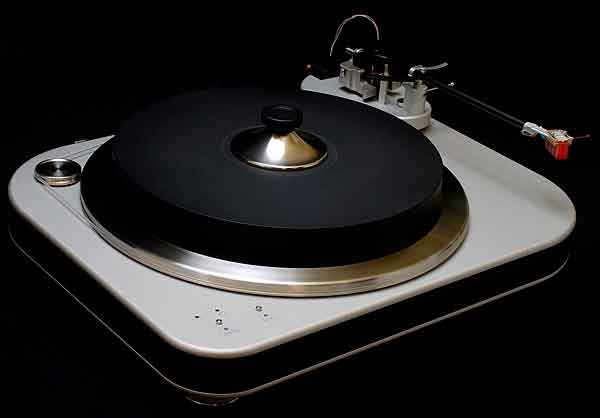 |
Spiral Groove SG1.1: $25,000 without tonearm The 75-lb SG1.1 is a remarkably dense, belt-driven, split-plinth design with an onboard AC synchronous motor driving a 22-lb platter of graphite, vinyl, and phenolic. While the SG1.1's clever tonearm-mounting system allows for simple installation of most any arm, Spiral Groove's complementary Centroid tonearm is designed for optimal system stability. Build quality was superb. Possibly the quietest turntable-tonearm combo in Mikey's experience, the SG1.1-Centroid matched black backgrounds with delicate highs, natural attacks and decays, and rock-solid bass. (Vol.35 No.11) |
 |
Spiral Groove SG2: $15,000 Well built, simple to set up, and bulletproof in operation, the SG2 is designed by Allen Perkins and represents an evolution of design and production capabilities from his RPM turntables. Though similar in appearance to the RPMs, the Spiral Groove uses a five-layer chassis—two thin layers of damping material separated by three aluminum plates—and a thick, anti-vibration platter comprising layers of aluminum, an impregnated phenolic, vinyl, and graphite. The bearing assembly has been optimized to eliminate radial movement and prevent stray magnetic fields from interacting with the cartridge. The SG2's dramatic timing, authoritative midrange, and superb resolution of detail worked to present music with an urgency and wave-like drive, said BD. Through the SG2, "[a recording] became a performance," he enthused. (Vol.33 No.6 Read Review Online) |
 |
TechDAS Air Force One: $97,000 See "Analog Corner" in the April 2013 issue (Vol.36 No.4). |
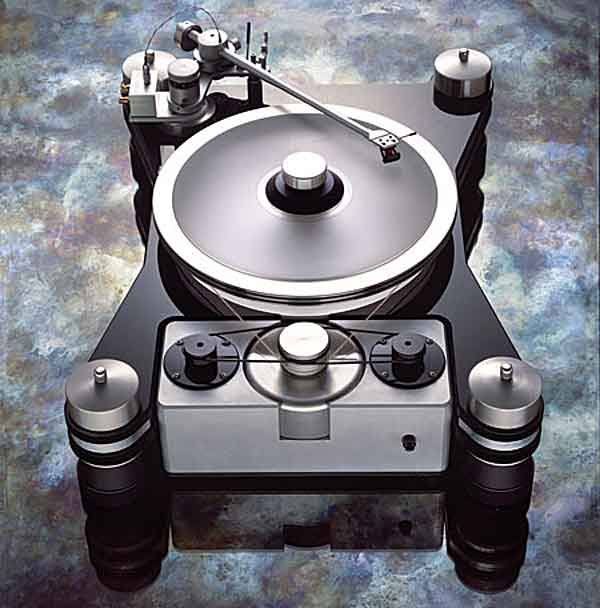 |
VPI HR-X: $13,000, with tonearm ✩ Harry Weisfeld's efforts to produce the ultimate TNT turntable include a plinth of acrylic-aluminum-acrylic laminate, an inverted bearing assembly, the addition of a perimeter clamping ring, and replacement of the outboard motor and flywheel with a single unit. Simpler, smaller, more luxuriously appointed, and better built than the TNT, the HR-X also eliminates the TNT's pervasive warmth and softened dynamic transients, to offer a much more neutral overall presentation. BD: "The HR-X struck me as a stable, inert, and nearly neutral platform that simply supports a cartridge and lets it do its job." Price includes VPI's JMW-12.6 tonearm (see "Tonearms"). (Vol.29 No.5 Read Review Online) |
 |
VPI Super Scoutmaster Reference Rim Drive: $10,000 ✩ The Super Scoutmaster Reference Rim-Drive combines the Scoutmaster's Super Platter with the Super Scoutmaster's Mini-TNT Stabilizer feet, and uses a rim-drive motor system based on the HR-X's dual-motor/flywheel module. It comes equipped with a JMW-10.5i Memorial tonearm fitted with Nordost Valhalla wire. The sound was "fantastic," with impressive bottom-octave heft and slightly warm high frequencies. "The Super Scoutmaster Reference Rim-Drive is one of the best values of the true high-end turntables now available," said MF. (Vol.32 No.2) |
 |
VPI Classic 3: $6000 Like earlier Classic models, VPI's most recent design is easy to set up, relatively compact (22" W by 10" H by 16" D), and uses a motor that has been integrated into its plinth. Refinements over earlier models include a more massive, better-damped plinth structure, newly designed feet, and an 18-lb damped aluminum platter. Though the Classic 3 wasn’t as quiet as MF's much more expensive Continuum Caliburn and couldn’t match the rich midrange of Dr. Feickert's Blackbird, the VPI had a clean, fast, lively sound marked by masterful attacks, outstanding microdynamics, and lifelike textures. "One of today's great values in analog audio," concluded Mikey. "I don’t hear how you can go wrong buying one." Borderline Class A. Price includes the new JMW-Classic tonearm. See "Tonearms." (Vol.34 No.10 Read Review Online) |
 |
Wave Kinetics NVS Reference: $45,000 Made in a California factory that specializes in microrobotics, the NVS Reference is superbly built and has a dramatic physical appearance: A large sculpted pod forms a central pillar and holds the motor, a custom DC design governed by a "laboratory-grade" commercial servo-controller with an active, ultrasonic feedback loop that produces a claimed speed accuracy of 1 part per million. Atop the motor is the NVS's 30-lb platter, which comprises three slabs of aluminum interleaved with two slabs of a mass-loaded white polymer. The turntable's platform is machined from billets of solid aluminum and includes a proprietary vibration-damping material. Compared to the Continuum Caliburn, the NVS Reference had similar bass extension and control, but offered slightly drier textures, muted attacks, and less dimensional images, said MF. "A top-shelf turntable that's easy to recommend," he concluded. (Vol.35 No.10) |
Комментариев нет:
Отправить комментарий